#simultaneous hermaphrodites???
Text
Would You Still Love Me? Part 2

Reiner x fem reader; established relationship; college au; comedy-fluff
synopsis: Reiner's love for you is tested in a way neither of you saw coming... The next day, he discusses the issue with his friends. Think they'll be any help?
warnings: none
notes: Part 1 beta read by @reiner69er. Banner made by me. Dividers by @delishlydelightfuldividers. Comments help earthworms grow large and healthy!
taglist: @ariasfandom

“So...” Sasha blinks, peering into the jar that sits on the table in front of Reiner. “Y/n turned into a worm, and… you’re keeping her in a jar now?”
Reiner covers the container with a piece of paper again, stifling a yawn. He hadn’t slept much, and had to admit he had been a little gutted when he’d awoken that morning to see that you were still a worm. He’d hoped maybe you’d… sleep it off or something?
“The jar’s just temporary until the aquarium and things get here.”
“Aquarium? She’s not a fish, Reiner,” says Connie, who is busying trying to finish last week’s assignment before the professor collects them that day.
“The stuff I found online said she’ll do best in a habitat with alternating layers of sand and potting soil so there’s be enough nutrients and moisture. I was up late reading about it.” Reiner tiredly rubs his face as the others stare at him.
Bertholdt, who spent the night at Armin’s dorm, rolls his eyes but says nothing.
“And you brought her to class with you because…?” Ymir prompts, a smirk playing on her lips.
“I just want to keep an eye on her, in case she suddenly changes back or something. I’ve got her phone in my pocket, and if her family calls I wanna be able to tell them I know exactly where she is.”
There’s a deeply uncomfortable pause, and Ymir opens her mouth but is interrupted.
“Well, I think it’s sweet!” Historia declares, trying to avoid an escalation of whatever is going on with Reiner. “Reiner, how can you, uh, how can you tell the worm is a she?”
“Um...” Reiner shifts uncomfortably, a hint of a blush on his cheeks. “Well, Armin says earthworms are actually uhh...”
“They’re true simultaneous hermaphrodites.” Armin finishes the sentence for him. “They have both complete male and female reproductive organs. They can’t self fertilize, though, so in a way, they function as one sex as a time during mating.”
"Yeah," Reiner says gruffly. "But y/n is a she, because she's always been. That's how gender works, right?"
“Oh, that’s beautiful!” Ymir laughs. “You must be relieved, Reiner. You and your hermaphroditic girlfriend-worm make an adorable couple. I bet they’ll even make a Lifetime movie out of your story.”
“Haha, yeah!” Connie wheezes. “They can call it, ‘Worms of Endearment!’”
Reiner is too pissed off to admit that that’s actually pretty funny. You’d probably have laughed out loud, he thinks, if you weren’t currently a worm.
“I wanna see y/n up close and see if she remembers me!” Sasha says, grabbing the jar before the sleepy Reiner can stop her.
She removes the paper and reaches in and picks you up, but you’re wet and wiggly and almost immediately slip out of her fingers, falling several feet onto the filthy floor. Sasha freezes. The fear in the room is palpable as Reiner springs from his seat and dives across the table, falling gracelessly onto the floor and cupping his hands over you to shield you from the many pairs of surrounding feet. His gaze snaps to Sasha, and his golden eyes are icy enough to send the girl into a frantic apology.
“I-I’m sorry! I didn’t mean to drop the girlfriend!! – I mean, your worm! – I, I mean, I –”
With a low growl worthy of a dog guarding a marrow bone, Reiner orders to Connie, “Give me your water bottle.”
Too afraid to question why, Connie hands him the bottle. Reiner pours a little water onto his hands, then gingerly picks you up off of the floor and uses the rest of the water to carefully rinse you clean of any debris, before setting you back down in the dirt in your container. He’s practically holding his breath, watching until you start to burrow back into the soil.
He sighs in relief and gets to his feet and grabs his bag and slings it over his shoulder, then gives Sasha another dirty look before leaving the classroom, holding your jar in both hands as if it might jump away. Everyone watches, wide-eyed.
Ymir scoffs, breaking the tense silence. “Tsh, what a man child. His girlfriend skips their afternoon make out session for a day and he’s already doting on a literal bug and pretending it’s her? Sheesh, no wonder y/n dipped. What a freak show.”
“Well… worms aren’t bugs. They’re annelids.”
“Great defense, Arlert. I take it all back. Makes what he’s doing seem perfectly normal.”
Bertholdt stares at the table. It really isn’t like you to go somewhere without telling Reiner, or to leave your phone behind. Could something have really happened to you? He makes up his mind that he’ll have to find you himself.

As class ends and the room empties, Bertholdt motions to his friends to wait. “Have any of you seen or heard from y/n since yesterday afternoon? That’s when Reiner says she, um, turned into a worm.”
Armin shakes his head. “I asked Mikasa. She said that y/n has an evening class on Tuesdays, so she and Reiner always meet around 4:30 to hang out behind the auditorium. I... don’t know why she knows that. Anyway, she saw y/n leave one of the lecture halls not long before that. She said y/n seemed tired, and Mina Carolina says y/n didn’t show up to the evening lecture. Maybe she felt sick and went home? It still doesn’t quite make sense, though.”
"Could this all be some elaborate prank they're both playing, and Reiner is just a way better actor than any of us ever thought he'd be?" Eren asks, joining them. Armin and Bertholdt filled him in on the details last night.
“His having her cell phone is pretty suspicious,” Armin points out.
Ymir shrugs. “Maybe he killed her. Maybe he just snapped, and then the guilt made him break from reality and convince himself she turned into a worm.”
“Ah, that’s stupid,” Connie waves it off. "Reiner's practically golden retriever in human form around y/n. He'd never hurt her."
“Maybe he’s got a dual personality,” Ymir counters.
“Ymir, please don’t let Reiner hear you making jokes like that,” Bertholdt says with a sigh. “Skipping classes for a weird prank like this is a little extreme, right? Look, my theory is that they had some kind of dispute--”
“And he killed her.”
Bertholdt ignores Ymir’s interjection and continues, “And she told him she wanted to take a break, or maybe even break up. She was probably so upset by that that she skipped her evening class and went home, and Reiner was so devastated that he...”
“...went totally insane?” Connie offers.
“I was going to say, ‘retreated into a comforting fantasy.’”
“Okay, but, he doesn’t exactly seem comforted, does he?”
“It’s a little over the top,” Bert admits. “But even though Reiner acts like a jock, he’s always been really sensitive deep down. When we were little, Porco told him the Rugrats all died in a plane crash and Reiner cried so hard he threw up a little.”
“So, if you’re right, how do we snap him out of it?” Eren wonders.
“What if we get rid of the worm? We could sneak in and take it and let it go somewhere. Maybe once the worm is really gone, he’ll have to face reality.”
“Wow, Armin, that’s cold!” says Connie. “And besides, Reiner might literally kill us. You saw how he looked at Sasha when she dropped y/n by accident.”
Bert thinks for a moment. “I... I don’t think I could do that to Reiner. I think the first step would be getting him to admit something went wrong between them. Then maybe the rest will fall into place. I’ll try to get him talking tonight. In the meantime, I think we should avoid mentioning the worm around him, even if he’s carrying it around. That’ll just encourage his fantasy, right?”
As they all file out into the hallway, the others seem to agree, and as they go their separate ways, Ymir can be heard whining to Historia, “If I disappeared, would you go insane and pretend I’d turned into a worm because you love me so much?”
Bertholdt, meanwhile, wonders where Reiner was headed with the worm...
Part 3 coming soon
#reiner#reiner braun#reiner x reader#armin arlert#bertholdt hoover#bertholt hoover#connie springer#eren jaegar#eren yeager#historia reiss#sasha braus#ymir#attack on titan#aot#fluff#comedy#simultaneous hermaphrodites???#worms of endearment#I crack myself up#I laughed about the Rugrats line for way too long#would you still love me?
112 notes
·
View notes
Note
not to be a little kinky shit or whatever... but how are the boys with... uh hum... self love? Keith seems like the type to only really do so out of necessity, when tension builds to be too much in his body, and Lotor seems to be the type to not consider such luxuries. What do you think?
I think the both of them are rather,,, practical, in that regard, though of the two of them Keith is by far the more likely to get riled up as it were, due to his general disposition. Given that libido can be affected by a wide range of factors—including stress/anxiety/depression/sleeping problems, all of which both our boys are currently struggling with—it's not unreasonable to assume that the high stakes of intergalactic warfare might be putting a wee bit of a damper on their sex drives. The other thing to consider, of course, is the impact of galra biology. As mentioned when discussing fertility cycles and penile structure, the galra as a species are monestrus, (meaning that they only have one period of fertility per planetary cycle), and so in the springtime phoeb of Eyiintak male galra experience increased levels of testosterone production; this, in turn, heightens both aggression and virility, so while it's far from inducing some uncontrollable animal urge (LB's not that kind of fic lads) it does leave male galra erring on the side of energised, impulsive, and, for lack of a better term, horny.
So all that being said, Keith would likely be quite perfunctory in dealing with his needs if they so arose (badumtss), whereas Lotor—despite being the type to thoroughly indulge if circumstances allowed—would, in his current situation, probably attempt to will the issue away altogether.
#this is only loosely adjacent but I was watching sir david attenborough's Wild Isles the other day so I have a fun fact for you all:#the ash-black slug's penis is as long as its //entire body// and—bc they're hermaphrodites—they impregnate each other simultaneously#isn't our planet ridiculous god i love weird biology#Ao3 Little Blade#sa screams back#galra history & culture#keith kogane#prince lotor#keitor
34 notes
·
View notes
Text
Thanks to @fishbeholder for letting me know about Hox genes. After this paragraph is an in-universe description of dragons, all real-world locations described in the text are equivalent of not direct 1:1 comparisons; for Reath, I’m using our world as a map and outline but many of the details are vastly different.
Dragons have a mutated Hox Gene causing them to have an extra set of small limbs. This mutation happened sometime during the early Jurassic era; these limbs were originally only used for mating displays. Though in one species found in Southeast Asia, these fins evolved into tools for gliding. This arboreal species was much smaller than those we know and recognize as dragons today. This was the only draconic species that survived the K-T extinction event.
With the skies open after the extinction of non-fay pterosaurs, the niche of flight was available for anyone willing to grab it first.
Yes, birds got there first by just a few million years, but they never really grew much use for magic, generally preferring more mundane means of flight. The only species within the class that bear any major magic ability are harpies, sirens, phoenix, and Rocks. So Dragons fully embraced the niche of massive magical flyers.
During the Pleistocene, with the explosion of megafauna, the growth of dragons followed. This period is where the only major split of the draconic class happened. With the early semi-aquatic forest-dwelling smooth Dragons moving into rockier, flatter terrain and deeper seas: The mountain-dwelling horned dragons, the forest-dwelling sail dragons, and the fully aquatic finned dragons were born.
During this time, there was an intriguing mammalian upstart in Africa who grew a deep coevolution with dragons were born. Maybe you've heard of these two-legged hairless apes. While the interactions between early humans and dragons are challenging to study, it is known that humans and dragons hunted the same prey and lived in the same regions. Many traditions say Dragons taught humans magic, speech, and how to make fire.
Though it is known that dragons and humans must have been able to find some sort of truce. Early humans had no way of defending themselves against dragons, but entire generations of humans could be born, reproduce, and die in the time it takes for a single dragon egg to hatch and reach sexual maturity. So while any one-on-one fight with a dragon would easily defeat any human, the death of a single dragon, especially young dragons, could devastate the entire population. But we found peace
Dragons are deeply magical creatures, and without this magic, they would not be able to function at all; their bodies are too heavy for their bones to carry them, let alone fly. They also simply cannot live off of consumed calories alone, their hibernation periods being used to take in, filter, and store magical energy inside their bodies like batteries for their animated periods
While it is unknown if dragons were the ones to teach humans basic magic, it is known that humans taught dragons refined spellcasting. Only a handful of species are known to purposely and consciously manipulate the magic around them rather ten passively using it as a means of predation or defense. In other words, true spellcasting. Dragons are also the only known species, outside of humans, to not take their magic through the filter of Fairy; instead, they directly manipulate the magic from the magical plane.
This leads us to today; dragons are our collaborators, an equivalent to humans, if not surpassing us. Another species that is considered to be a person amongst us fay and sephlopods. While dragons as a species live very different lives to us, you may be surprised to meet one on the street or have one as a coworker, they are rare; with only a few thousand alive today, and only a fraction of those living outside their suspended animation but they are people, our peers, and living history. Though we may need to return to the amniotes to find our common ancestor, I am happy to call dragons brethren.”
- Prof. Julian Corzo
Space Magazine, October issue 2012
#thoughts#dragons#fantasy#fantasy biology#speculative zoology#speculative biology#unreality#this dosent even mention that dragons are simultaneous hermaphrodites#or that thier horns sails and colorations are still used for mating displays even today#the writing demon got me on this one#i was just going to do a quick continuing thoughts from my previous post but then started writing in the voice of a researcher#then i just leaned into it#so enjoy#tanks again @fishbeholder!
26 notes
·
View notes
Text
If I ever write a fic heavily leaning on Loki and his Jotun heritage, I will model their reproductive and social structure on clownfish, but with magic instead of anenomes.
#random#simultaneous hermaphroditic jotun are out#protoanderous jotun with one powerful female per magical nexus are in#mcu#-ish#world building bunnies
0 notes
Text
Had Finding Nemo been biologically accurate, Nemo’s father would have likely changed sex to become female following the disappearance of Nemo’s mother and Nemo would have been like other anemonefishes, developing as an immature female who would likely have matured into a functional male to form a breeding pair in the social group. (source)
1 note
·
View note
Text



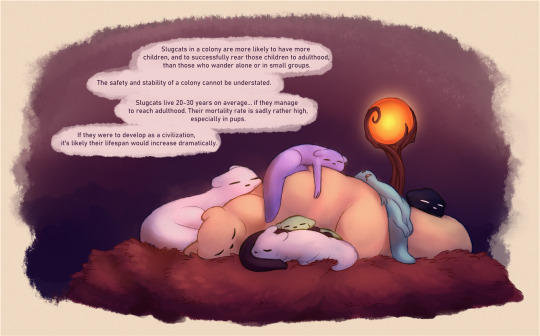
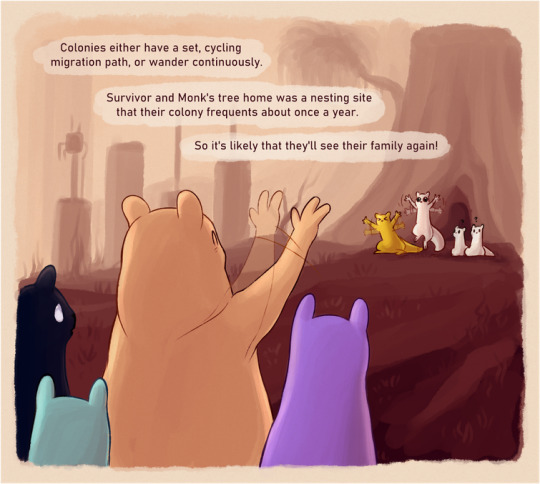


Playing with some ideas mostly regarding gender/reproduction in RW, and slugcat colonies.
Full transcript under the cut!
Creatures in Rain World are typically simultaneous hermaphrodites but require partners to reproduce, with either individual capable of being a genetic donor or carrier. Alongside what we are familiar with, this has lead to interesting reproductive strategies such as rotating donor/carrier roles, or dual/simultaneous genetic swaps.
Rotating donor/carrier roles - A K-selection reproductive strategy. One partner carries the first child, the other partner carries the next child, and so forth. Allows each partner to recover from the demands of childbearing.
Rain Deer aren't quite monogamous, but they tend to choose the same breeding partner whenever mating season rolls around. They serve as a donor one season, then bear and raise a child the next. Calves are raised away from the rain and worm grass, in places that have less food but more safety. Calf wool is softer, not yet gunked up by the dirty rainfall. Their legs are sturdier as children, allowing them to run for cover while the parent wards off threats.
Dual/simultaneous genetic swap - An r-selection reproductive strategy. Parents fulfill the donor and carrier role for each other. The more children you make, the more likely some are to survive!
Multiple batflies lay thousands of eggs in a single "blue fruit." Several eggs congeal and become nutrient paste for the surviving eggs (and for hungry slugcats). Like some plant seeds, batfly eggs that are consumed before pupating can survive passing through the digestive system. Ew.
Ancients also fell under this umbrella. Their genders (and the genders of iterators by extension, who have no sex anyways) could have been determined by a variety of other factors, such as societal role, donor/carrier preference, or simply different categorizations of personal expression.
It's difficult to say how well their common pronouns would translate to ours, but it seems they can translate to an extent, given what Moon and Pebbles use canonically.
Slugcats, like real slugs, can have children with a partner or self-fertilize. Unlike real slugs, they are often known to adopt.
In the case of self-fertilization: children who are born from one parent may display a large amount of genetic diversity despite the circumstances. Maybe slugcats have some sort of... genetic reservoir independent of their own genetic code?
Slugcats live 20-30 years on average... if they manage to reach adulthood. Their mortality rate is sadly rather high, especially in pups. If they were to develop as a civilization, it's likely their lifespan would increase dramatically.
Slugcats in a colony are more likely to have more children, and to successfully rear those children to adulthood, than those who wander alone or in small groups. The safety and stability of a colony cannot be understated.
Colonies either have a set, cycling migration path, or wander continuously. Survivor and Monk's tree home was a nesting site that their colony frequents about once a year. So it's likely that they'll see their family again!
...also, the strength of large colonies are why scavengers are likely to become the dominant species. In the time of Saint's era, continuous migration has become more of a risk, and it has become more difficult to support large populations. Slugcat populations have shrunk back to the more forgiving equatorial zones.
Saint's tongue is pretty unusual and probably unique to them, or to a small population that they hail from. Fur (of varying thickness) is much more common.
Meanwhile, scavengers are bulkier and covered in thicker insulating fur. They:
have seemingly massive populations
have a burgeoning society (the existence of merchants, tolls, bartering, elites and leaders)
are adept at communicating (non-verbally)
manipulate their environment
can build structures (scavenger-made structures were a scrapped idea from Saint's campaign)
can create complex weapons and tools
may have agriculture behind the scenes (unsure if scout parties prioritize exploration or hunting)
I would wager on scavengers developing more quickly than slugcats, but it would be nice if there was a future where both could co-exist.
#oops! impromptu rendering practice!#rotating donor/carrier roles could also be an r-selection strat#but i feel like it'd be more common as a k-selection strat#rain world#worldbuilding#headcanons#flickerdoodles#art#um#ask to tag?#that goes for all of my posts#rw spoilers#dp spoilers#saint spoilers#long post
2K notes
·
View notes
Text
It's October and I want to talk about something creepy, so this Wet Beast Wednesday is about the lancetfish. These things look like what would happen if a fish became a vampire. Lancetfish are the only members of their family, Alepisauridae and consist of two species: The longnose lancetfish Apleisaurus ferox and the shortnose lancetfish Apleisaurus brevirostris. While they are often caught as bycatch, there is still a lot we don't know about them.

(image: a lancetfish held by an angler. Its body is long, skinny, and silvery. Its dorsal fin extends down most of its back and is supported by a series of long, thin spines. Its head is pointed and the moth is very wide. It has a large, green eye. The tail is out of frame)
Lancetfish are long and skinny fish capable of reaching up to 2.08 meters (6.8 ft). Their dorsal fins are especially notable, stretching down most of their backs and being spiny, resulting in one common name for them being the "handsaw fish". The fin likely gives stability when the fish swims fast and can fold down. The fin is situated in a groove so when it folds down, the top of the fish is smooth and reduces drag. Lancetfish are also one of the relatively few fish to have an adipose fin. The mouth is large and opens very wide. It has long, skinny teeth that point backwards and are adapted to hold onto struggling prey. Their bodies have no scales, only smooth skin with pores for the lateral line. The name "Alepisaurus" means "scaleless lizard", a reference to their body shape and lack of scales. The stomach can expand to hold a very large volume. Lancetfish lack swim bladders and are simultaneous hermaphrodites, posessing male and female gonads at the same time. They show some anatomical differences from other hermaphroditic fish, including testicles that are independent from the ovaries.
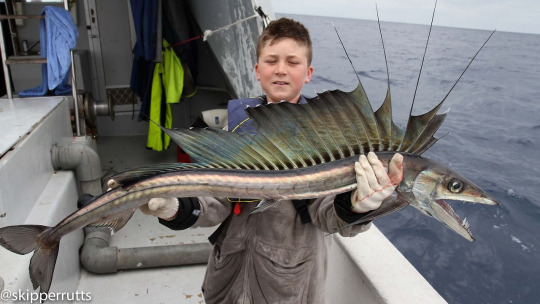
(image: a lancetfish held by a child on a boat. More detain can be seen on the dorsal fin, which includes four spines that grow long past the webbing. The tail ends in a forked fin.
Lancetfish are found worldwide except for arctic regions and are more common in temperate to tropical waters, but have been found as far north as Greenland. They are found in the mesopelagic (twilight) and bathypelagic (midnight) zones, but sometimes swim closer to the surface and can be found at a huge variety of depths. They are unusually large for fish that live in those areas. They are generally believed to be solitary, but may gather together to mate. They may also be migratory, as they have been reported seasonally appearing and disappearing in some locations. Lancetfish do also travel to colder waters if food is scarce. They are predators with extremely wide diets that include fish, cephalopods, tunicates, and crustaceans. They are also notoriously cannibalistic, as lancetfish show up in the stomachs of other lancetfish very frequently. There have even beec cases of scientists finding a lancetfish inside of a lancetfish inside of a lancetfish. They are so well known for cannibalism that they are often named "cannibal fish". Lancetfish are likely ambush predators. Their muscles are gelatinous, which is unsuitable for chases but does work for sudden bursts of speed. They most likely hang motionless in the water, waiting for prey to pass. How lancetfish reproduce is unknown, but they are probably broadcast spawners.

(image: a lancetfish in its natural habitat. It is suspended vertically in the water, with the head pointing up. Its dorsal fin is folded back)
One interesting feature of lancetfish is how slow their digestion is. Lancetfish are often found with undigested or partially digested food in their stomachs. One hypothesis is that They digest food slowly wile living a low-energy lifestyle to make the energy gained from each meal last as long as possible. Another is that the stomach acts like storage and will only begin digestion if the fish is low on energy. This provides an interesting avenue of research. Lancetfish caught as bycatch or that was up on beaches can be dissected to investigate their stomach contents, which are so much more pristine than those of other species. This means each lancetfish acts as a net, containing tons of specimens that give us a good (if biased) look at the bathypelagic food web and local biodiversity. Scientists are starting to find a lot of plastic in lancetfish stomachs. It is hypothesized that some of this plastic may be ingested by prey who practice daily vertical migration bringing tiny pieces of plastic down into deeper waters where they are ingested by larger predators. Some plastic pieces found may be too large to be explained by this method alone, such as a fragment of a black plastic bag around the same size as a hand towel found in one lancetfish. This is part of growing evidence that shows plastic pollution is not just a problem for the surface as was previously though, but exists throughout the water column.
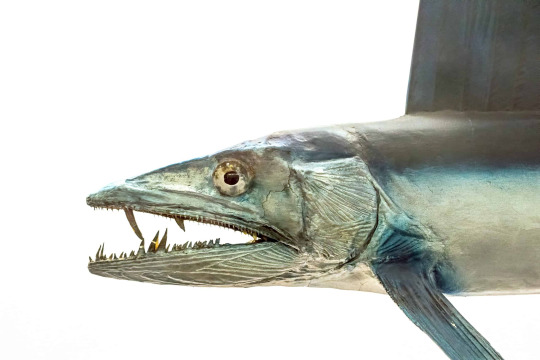
I told you, its a vampire fish (image: a close-up of a lancetfish head. Its mouth is open, showing the teeth. They are long, skinny, and sharp. Most are short, but a few on the top and bottom are much larger than the others)
Lancetfish are not commercially caught as there is no market for them. Their gelatinous meat is considered unappetizing, though it is also said to taste sweet. They are considered pests in longline fishing industries for taking bait intended for other species. The amount of lancetfish bycatch is increasing, possibly indicating population growth due to overfishing of their competition and prey. Known predators of lancetfish include tuna, cod, opah, salmon sharks, and sea lions. Because of how deep they live, not much is known about any conservation needs
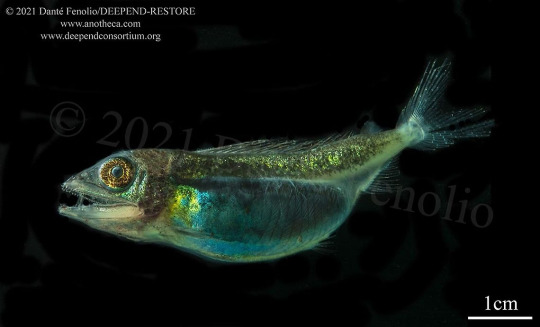
(image: a juvenile lancetfih. Its body is green and translucent and much shorter than that of the adult. The head has the same shape as the adult. The dorsal fin is much smaller and less distinct. The body is curved at the spine and the internal organs are visible through the skin)
#wet beast wednesday#lancetfish#lancet fish#fish#fishblr#marine biology#biology#zoology#ecology#animal facts#pictures#long boi
639 notes
·
View notes
Text
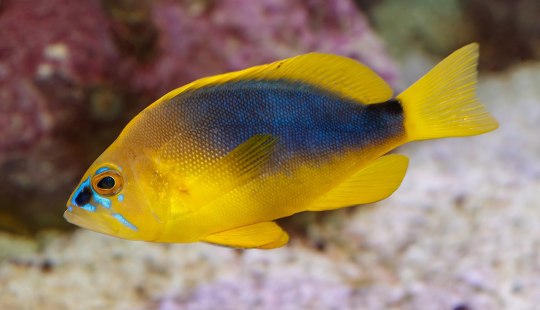
Shy Hamlet (Hypoplectrus guttavarius), family Serranidae, order Perciformes, found in the Caribbean
This species is a simultaneous hermaphrodite, possessing both male and female reproductive systems at all times through their lives.
During mating, the 2 partners take turns fertilizing each others eggs.
photograph by H. Zell
279 notes
·
View notes
Text
Did you know that earthworms visit each other's home burrows before they mate? This thought resurfaced as I was passionately writing tags about the beauty of animals, I realised this is something most people probably don't know. Earthworms like to visit each other's burrows most likely to make sure they're clean and lack parasites, to be sure that their children have a good start to life. And during mating the worms embrace each other closely as they exchange genetic material; both worms are simultaneously hermaphroditic and will carry eggs!
218 notes
·
View notes
Text
Why do people keep saying Mind Flayers are sexless?
I assume this is because they only look at the Fandom Wiki about Mind Flayers, and then somehow use this information to try and be upset about being able to romance Mind Flayers/The Emperor in Baldur's Gate 3, since the Fandom Wiki calls Mind Flayers sexless. However 'The Book of Aberrations' and 'Volo's Guide to Monsters' states this;

My best bet is that due to a Mind Flayers long life span and the rarity of them spawning, Mind Flayers are most likely Simultaneous Hermaphrodites, meaning they could either asexually reproduce through self-fertilization or reproduce with another Mind Flayer who is also ready to spawn. This means Mind Flayers are perfectly capable of sexual intercourse/reproduction.
Note: I also feel like people just seem to forget that one does not need to have sex organs in order to have sexual relations, compatible or non-existent when talking about fiction.

126 notes
·
View notes
Text
We often frame the medicalization of intersex children, as Preves puts it, as based in an “impetus to control intersexual ‘deviance’ [that] stems from cultural tendencies towards gender binarism, homophobia, and fear of difference.” Yet the clinical history of the Harriet Lane Home leads to a different argument. Wilkins’s labored attempts to reconcile electrolyte metabolism and its sexual version through the technologies of hormones, salt, and patient charts describe a scenario where “control” is at most a perpetually deferred horizon, not an outcome. Cortisone therapy is more consonant with Repo’s argument that “the hermaphroditic subject was a subject of biopolitical potentiality: a subject who, through the surgical alteration of genitals, could be psychologically managed into a different-sex desiring subject and hence become a subject useful for the reproduction of social order.” Cortisone therapy was meant to address the young child’s plasticity in a normalizing sense, to remedy the adrenals at the same time that it feminized the body, recalibrating development along a binary trajectory. However, in its salt-losing version, incredibly virulent embodied plasticity constantly interfered with the isolation of “sex” as a distinct “part” of the body, frustrating the metonymic slide from life-threatening medical conditions to arbitrary binary models of human phenotype and genitals. This inability to isolate sex was a dramatic incarnation of the epistemological crisis of sex that plasticity had generated over the first half of the twentieth century, and it manifested specifically on the endocrine ward as a radical metabolic openness to the environment. As Wilkins so often found, diet and stress in the clinical setting often overrode the action of cortisone in the midst of treatment, throwing resonance off without advance warning.
[…]
The reason that Wilkins was willing to cling to binary sex in cases of salt-losing CAH, I argue, even when that could put the life of the patient at risk, is that the binary imperative was a racialized phenotype. The crucial detail was scrupulously recorded by Wilkins in a 1952 article he published in Pediatrics: each of the patients upon whom he experimented to produce the protocol for salt-losing CAH was “a white female” or “a white infant.” That whiteness names an investment in a racial normativity that had previously been articulated as eugenic stock during Young’s surgical paradigm. As the transition to the postwar era heralded the end of an explicitly eugenic language of race improvement and extermination in the life sciences, the eugenic preoccupations that had typified endocrinology during the interwar period rhetorically faded. It would be a mistake, however, to assume that the eugenic techniques underwriting modern endocrinology similarly ended in the 1950s. On the contrary, the experimental use of cortisone illustrates continuity in practice. Wilkins aimed to resolve a metabolic condition that would simultaneously normalize the growth rate, metabolism, and sex of the body, directing it toward a binary phenotype that was merged with the resolution of the salt-losing crisis. The whiteness of these children was so valuable as a racial formation that it allowed Wilkins to justify putting children’s lives at risk to achieve a binary sex as humane practice, presaging Morland’s argument about Money.
Jules Gill-Peterson, Histories of the Transgender Child
92 notes
·
View notes
Text


Small lesson on Koolu reproduction.
They are hermaphrodites with their genitals at their rear end. Both partners can get preggo simultaneously during the deed. They usually carry one offspring and give live birth.
53 notes
·
View notes
Text
*vomits this* i hate them so much
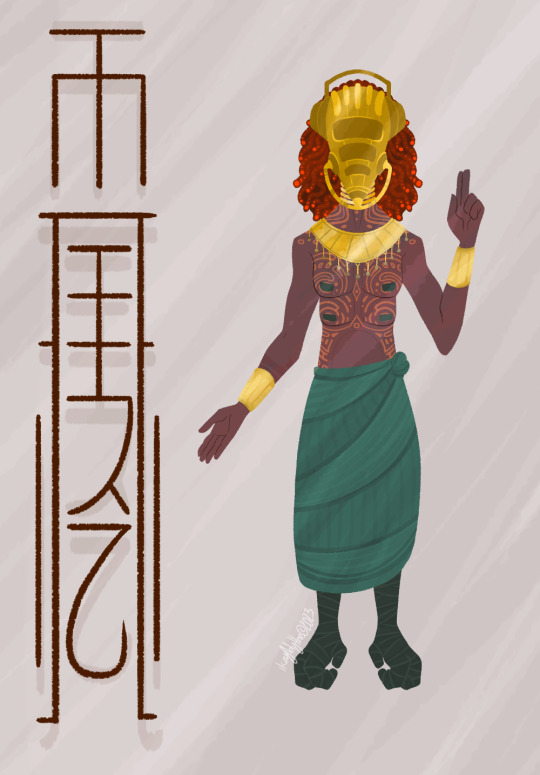
Nakey version and Lore below the cut in case people dont like alien boobs

"Humans* were a bipedal species that rose from the depths of the glacial caverns to colonise the surface of their frozen world. Their ancestors had splayed feet for the snow and horizontal pupils for scanning the ice sheets, lined by dark markings to protect their eyes from the glare of the light scattered everywhere. Like most ancient fauna, they were typically dark in color to shield against the ultraviolet rays of their unstable sun.
Human hair evolved from sensory tentacles that helped navigate the underground, covered in bioluminescent photophores to signal to companions. It's not uncommon to still have feeling tentacles above the eyebrow and around the mouth.
Like most fauna, humans were simultaneous hermaphrodites. They possessed four mammary glands—believed to have eventually influenced the association of the number Four with abundance and later gluttony.
Most human societies frequently modified their bodies, decorating themselves in body paint, with any "impurities" often cast out and replaced with cybernetics. Sometimes, appendages were deliberately removed and replaced in the belief that an artificial body inspired less attachment. Children had their ears cropped in anticipation for frequent mask usage: a necessity in the iterator cities, where higher elevation means thinner air. Surface dwellers were able to get by without masks for a while until the air below became suffocating with the increasing humidity, not to mention a breeding ground for air and waterborne disease.
Most masks double function as headphones and AR interfaces. The modern human would have experienced the world in a way only accessible by their mask; an AR internet that disappeared along with the rest of them."
*I call them humans because there arent any real names for them. The basic etymology for 'human' is 'of the earth,' and it could be assumed that they had their equivalent. But im not gonna conlang for rain world nuh uh so yall get the translation instead
#digital art#artwork#rain world#art#artists on tumblr#digital illustration#rainworld#original art#rw#rain world fanart#rain world art#worldbuilding#rw ancients#rain world ancients#i hate drawing their masks btw#grrrgrrrgrrrrtr#if u think the proportions are weird thats intentional#i went for the Human but Not Quite approach#alternate earth ig?? sdgsgghcg
78 notes
·
View notes
Text
Phaerimm
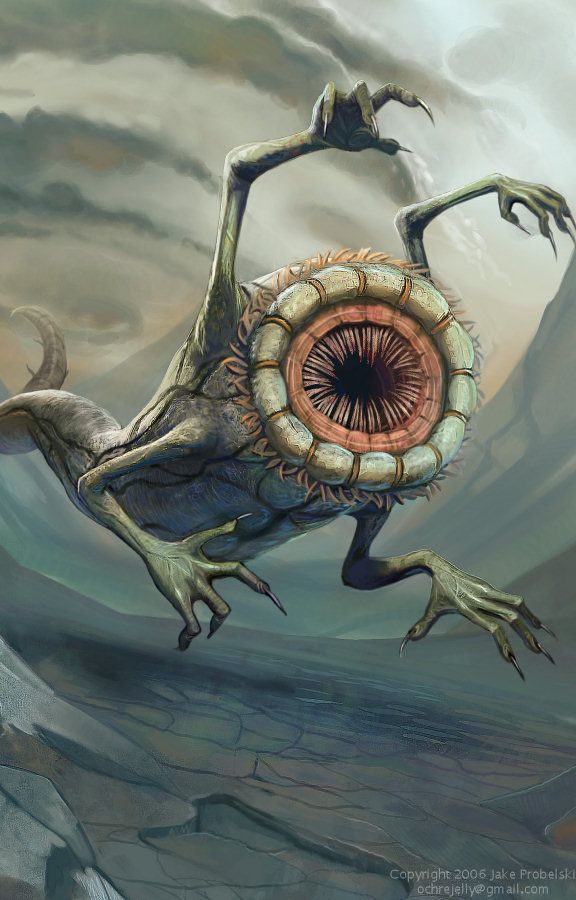
Image © Jake Probelski
[Sponsored by @coldbloodassassin. The phaerimm are theoretically one of the foundationally important monsters in the Forgotten Realms setting, being tied closely to the Netherese, the sharn and other bits of lore. But they always struck me as kind of boring. They're yet another magically gifted aberration that views humanoids as slaves and cattle. And their stats seem to get more pared down and less interesting with every edition. I went back to their first mechanical appearance in AD&D 2e for inspiration.]
Phaerimm
CR 12 NE Aberration
This creature floats in the air, looking something like a flying sea anemone. It has a circular maw with eyes dotting its rim, four arms with clawed hands, and its body tapers into a long tail, ending in a stinger.
The phaerimm are strange aberrant creatures native to a deadly desert world in another galaxy. Phaerimm have not mastered planetary travel, and are found on other worlds typically as the descendants of captives and experimental test subjects enslaved by wizards looking for alternatives to celestials and fiends. It may be that the phaerimm sowed the seeds of their own calling, as they can be summoned through magic much more easily than other aberrant creatures. Most of these itinerant phaerimm are interested in converting other planets into worlds more like their own, and seek powerful magic items and ritual spells in order to drain the vitality from ecosystems and render them deserts.
Even a newly born phaerimm is a powerful magic user, and they use their spells preferentially over their formidable physical talents. Phaerimm are spontaneous casters, but can convert some of their spells into spell-like abilities to make them easier to cast and harder to counterspell. The vast majority of phaerimm are sadists, which can be used against them; a phaerimm will often make suboptimal tactical choices if it has an opportunity to spread more pain. Phaerimm are slavers, and view enslaved or magically controlled minions as utterly disposable.
The phaerimm are simultaneous hermaphrodites, able to both fertilize the eggs of other phaerimm and be fertilized in turn. Phaerimm courtship is more akin to a business exchange than anything romantic, and the eggs are kept in suspended animation until they can be inserted into a host—mammalian creatures are preferred, but anything living of Small or larger size can provide sufficient nutrients for the parasitoid embryo. Phaerimm keep their incubators secure, stocking their lairs with galleries of floating, insensate victims, each one growing a new horror inside.
An adult phaerimm is about twelve feet in length and weighs six hundred pounds. They fly magically, and are practically immobile in an antimagic field or similar effect.
Phaerimm CR 12
XP 19,200
NE Large aberration
Init +5; Senses all-around vision, arcane sight, darkvision 60 ft., Perception +20, see invisibility
Defense
AC 25, touch 10, flat-footed 24 (-1 size, +1 Dex, +15 natural)
hp 150 (12d8+96)
Fort +11, Ref +7, Will +12
DR 15/magic; Immune petrifaction and polymorph; SR 23
Defensive Abilities absorb magic; Weakness callable
Offense
Speed 5 ft., fly 30 ft. (good)
Melee bite +14 (2d6+6), 4 claws +14 (1d6+6), sting +14 (1d8+6 plus paralysis)
Space 10 ft.; Reach 10 ft. (5 ft. with bite)
Special Attacks implant, paralysis, prepare spell-like abilities
Spell-like Abilities CL 13th, concentration +18
Constant—arcane sight, see invisibility
3/day—blur, shield
1/day—enervation, haste, waves of fatigue
Spells CL 11th, concentration +17
5th (5/day)—dominate person (DC 21), waves of fatigue
4th (7/day)—crushing despair (DC 20), enervation, terrible remorse (DC 20)
3rd (7/day)—fireball (DC 18), haste, inflict pain (DC 19), ray of exhaustion (DC 18)
2nd (8/day)—blindness/deafness (DC 17), blur, bull’s strength, paranoia (DC 18), scorching ray
1st (8/day)—charm person (DC 17), mage armor, magic missile, ray of enfeeblement (DC 16), shield
0th—acid splash, detect poison, disrupt undead, light, mage hand, open/close, prestidigitation, resistance, touch of fatigue (DC 15)
Statistics
Str 22, Dex 13, Con 26, Int 18, Wis 19, Cha 21
Base Atk +9; CMB +16; CMD 27 (cannot be tripped)
Feats Arcane Strike,Empower Spell, Eschew Materials (B), Flyby Attack, Improved Initiative, Lightning Reflexes, Spell Focus (enchantment)
Skills Fly +18, Intimidate +20, Knowledge (arcana) +19, Knowledge (dungeoneering, nature) +16, Perception +23, Spellcraft +19, Stealth +12; Racial Modifiers +4 Perception
Languages Aklo, Common, Undercommon, telepathy 100 ft.
SQ undersized weapons
Ecology
Environment any deserts and underground
Organization solitary, pair or enclave (3-12)
Treasure double standard
Special Abilities
Absorb Magic (Su) Whenever a spell fails to overcome a phaerimm’s spell resistance, the phaerimm heals an amount of damage equal to the spell’s caster level.
Callable (Ex) A phaerimm is treated as an extraplanar outsider for the purposes of calling spells like planar binding.
Flight (Su) A phaerimm’s fly speed is supernatural in nature.
Implant (Ex) As a full round action, a phaerimm can lay an egg in a paralyzed or helpless target. The egg gestates for one week, whereupon a young phaerimm bursts from the host, killing it. While implanted with an egg, a host is unaffected until the final 24 hours of incubation, during which time it is treated as suffering a -10 penalty to all ability scores (minimum 1). A successful remove disease or similar effect against DC 23 removes the pellet, as does a successful DC 25 Heal check performed over the course of 10 minutes. Regardless of whether the Heal check succeeds or fails, it deals 1d4 damage to the host.
Paralysis (Su) A creature stung by a phaerimm must succeed a DC 24 Fortitude save or be paralyzed for one minute. After this duration elapses, the creature must succeed a second DC 24 Fortitude save or be paralyzed for 1 week. While paralyzed, the afflicted creature floats five feet off the ground.
Prepare Spell-like Ability (Su) When a phaerimm regains its spells, it may choose to prepare one of its known spells of each level above 0th as a spell-like ability with a caster level equal to its Hit Dice. 1st and 2nd level spells may be used 3/day as a spell-like ability, and spells of 3rd level or higher may be used 1/day.
Spells A phaerimm can cast spells as an 11th level sorcerer. A phaerimm does not gain other sorcerer class abilities, such as a bloodline, unless it takes levels in sorcerer.
40 notes
·
View notes
Text
Alternative language for biology of sex without using "hermaphrodite"
So, you're worldbuilding a scifi alien species or a fantasy race that can reproduce as both male and female. Or you're a biologist or science educator. And you want what you're writing/making to be inclusive to intersex people.
The term hermaphrodite in biology refers to species that can reproduce as both male or female. The problem is it's also a slur when used against intersex people (it's also incorrect - we're not hermaphrodites). I recently polled other intersex folks informally and a plurality were fine with the h-word being used with the correct meaning in appropriate contexts. But the qualitative feedback I got was, all things equal, most people who wrote to me said they'd just be happier seeing the term less.
So here is a glossary of words you can use to talk about the biology of sex without invoking the h-word:
Gonochoric species where individuals (typically) reproduce only as either male or female. This means the species produces two types of gametes that have different sizes, and conventionally the larger is female. Gono- for generation/reproduction and -choric for separated/distinct. Note that "non-gonochoric" includes both hermaphroditic species and those that can reproduce asexually (e.g. parthenogenesis).
Gonosyne: species where individuals (typically) can reproduce as both male or female. Gono- for generation/reproduction and syne for together/combined. This is a term I have coined to be an alternative to hermaphrodite.
Types of gonosyny: it's common to categorize different forms of gonosyny based on temporality and how many gonads an individual has.
Grouping by Temporality:
Cosex: species where individuals can reproduce as both male and female simultaneously. Alternative terms: cosexual, simultaneous hermaphrodism. For example: land snails/slugs typically mate by linking up both pairs of genitals.
Dichosex: gonosynic species where individuals reproduce as male and female at different times in their lives. Protandrous species start as male then switch to female; protogynous start female then switch to male. Some species cycle between the two (serial/bidirectional hermaphrodism/disexuality). Alternative terms: dichosexual, dichogamous, sequential hermaphrodism. I coined this one after feedback that "dichogamous" was not intuitive to non-botanists, keeping dicho- (in two parts/paired) for simplicity. Example animal: clownfish (the Finding Nemo fish).
Grouping by Gonads:
Digonic: species that can reproduce as both male and female because they have separate male and female gonads. Digony can be cosex or dichosex. In botany the term monoecious is used for flowering plants. For example: barnacles have their ovaries in the base of their body, and testes in the back of their head.
Syngonic: species that can reproduce as both male and female, because their gonads can produce both male and female gametes. Alternative terms: syncoecious, monoclinous, ambisexual. (Note ambisexual has other meanings.) Syngony can be cosex or dichosex. In dichosexual species the gonad changes which gametes it produces when the individual changes sex. For example: land slugs have a single gonad (ovotestis).
Together this makes four categories. Examples come from: Sex change in plants and animals: a unified perspective.
Syngonic cosexual. Simultaneous gonosyny within the same flower/gonad. Examples: Black-jack daisy, Lady of the Night cactus; mangrove killifish, stubby-root nematode.
Syngonic dichosexual. Non-simultaneous gonosyny within the same flower/gonad. Examples: Bromelia
chrysantha, grape ivy; California sheephead fish, common limpet.
Digonic cosexual. Simultaneous gonosyny from different flowers/gonads. Examples: bitter melon, jaraguá grass; barnacles, flatworms.
Digonic dichosexual. Non-simultaneous gonosyny from different flowers/gonads. Examples: papaya, catsfoot; staghorn coral, earthworm.
Hope this is helpful! I have two little notes I want to add on:
Note on "non-gonochoric": it's possible this could also include isogamous speries? There's some ambiguity in use. Isogamy refers to sexual reproduction where you don't have two different sized gametes - instead it's two identically sized gametes that are getting combined. This is the standard amongst unicellular eukaryotes and very common in fungi.
Note on ambisexual: this is the term that Ursula K LeGuin used for the dichosexual aliens in the Left Hand of Darkness. The term in biology these days refers to undifferentiated (immature) tissue that has yet to develop into a given sex - e.g. a human embryo has ambisexual gonads until sexual differentiation later on in development. The term ambisexual has a ton of other meanings in other contexts such as a sexual orientation. For this reason I'd personally avoid it.
#intersex#hermaphrodism#biology of sex#biology#botany#zoology#dichosexual#dichosex#dichosexuality#cosexual#cosex#cosexuality#syngony#digony#gonochoric#gonosynic#worldbuilding#sci-fi#writing#writing scifi#alien design#new term#ambisexual#xenobiology#speculative biology
75 notes
·
View notes
Photo
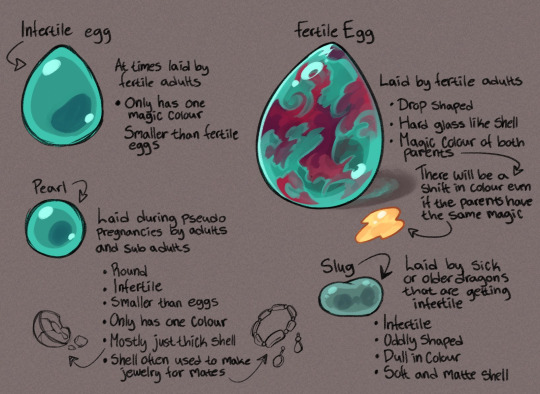
Here’s some old saurian egg lore! Mostly used for my ocs and probably won't be used much in the dtk+ au, but will be slightly relevant in the utmv au since it will involve ship kids uvu I will probably write a whole info post about the dragons’ life cycle at some point, but some quick notes:
Saurian dragons are simultaneous hermaphrodites, meaning that they have both male and female reproductive organs and can both sire and carry eggs.
Nurses and scholars will commonly have 3-5 eggs in a clutch, while guardians and scouts are more likely to only have 1-3 due to their more physical lifestyles.
While saurian dragons reach maturity around the same time that they receive their god claim, in their early twenties, they can’t produce fertile eggs until their forties or even sixties. This is one of the reasons why they’re pretty rare in some aus, as if a lot of them are wiped out it will take very long for them to repopulate and regrow their numbers.
Dragons only produce eggs every third to fifth year, which is another reason why their reproduction can be very slow.
Dragon eggs are very hardy and not easy to crack. The normal hatching time is around 6 months but eggs can sometimes go dormant for a couple of months longer. By absorbing the magic from their shells they can safely remain in their eggs should the conditions outside be dangerous, but it does make their shell more fragile and grey in colour.
61 notes
·
View notes